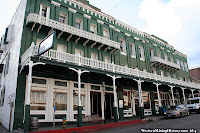Nevada City, California first became a town during the Gold Rush years.
The first “easterners” to come to the area built a cabin along Deer Creek. They staked a claim in 1849, just a year after the find at nearby Sutter’s Mill, which started the California Gold Rush.
The town’s first name was Deer Creek Diggins.
By 1850, it was decided that the town needed an official name. The name “Nevada” was chosen--Nevada is Spanish for snow-covered--because it had been a particularly snowy winter.
Through the 1850s and 60s
Nevada grew in prominence. It became a county seat in 1851 for the new state of
California. At its peak, Nevada had 10,000 residents.
But unlike most boom mining towns Nevada stayed lawful, in part because of the town’s leadership.
This was also in part due to a caste system that was put in place. The town’s working miners lived in Grass Valley nearby while the prosperous mine owners resided in Nevada.
But unlike most boom mining towns Nevada stayed lawful, in part because of the town’s leadership.
This was also in part due to a caste system that was put in place. The town’s working miners lived in Grass Valley nearby while the prosperous mine owners resided in Nevada.
The town went through one
more name change in 1864. The western part of Utah Territory was formed into
the new state of Nevada. So the word “city” was added to distinguish
between the two.
At one time, the stamp mills that surrounded Green Valley and Nevada City crushed ore from the underground mines 24/7 in search of gold. The last mines in the area were closed in the 1950s.
The town’s first hotel,
saloon, stagecoach stop, and mail center were known as Bicknell’s Block. The original building burnt down but it was rebuilt.
This building eventually became the Nevada Exchange Hotel. In 1977, this hotel was placed on the National Register of Historic Places and is considered the oldest continuously operated hotel west of the Rockies.
 |
| Nevada City Mine 1866 |
At one time, the stamp mills that surrounded Green Valley and Nevada City crushed ore from the underground mines 24/7 in search of gold. The last mines in the area were closed in the 1950s.
 |
| Ophir Quartz Mill 1866 Grass Valley |
This building eventually became the Nevada Exchange Hotel. In 1977, this hotel was placed on the National Register of Historic Places and is considered the oldest continuously operated hotel west of the Rockies.
In 1985, the entire downtown
area of Nevada City was registered as a national historic landmark.
This small town’s charm and beauty make it a tourist attraction today. It has many buildings that reflect Victorian, Colonial, Greek Revival, and California Gothic architecture.
This small town’s charm and beauty make it a tourist attraction today. It has many buildings that reflect Victorian, Colonial, Greek Revival, and California Gothic architecture.
One attraction for ghost
hunters is the National Exchange Hotel, just like the town this hotel has an interesting
history. This structure is haunted.
One female ghost is seen
in the hotel’s bar area and restroom. She was murdered in the hotel. It seems she
owed a man some money--unfortunately, she refused to pay him. One night
he broke into Room 48 and hid in the closet. When the lady returned, he slit her
throat. She haunts this room as well.
 |
| Known as just "National Hotel" today. |
Many guests have felt her presence in Room 78. Strange knocking noises are heard. Elizabeth is seen playing in the 3rd-floor hallways. She is seen riding a tricycle and skipping rope.
Yet another ghost at the
National is that of a man. He is described as wearing black pants, a white
shirt, and a black vest. He is seen walking up a staircase. Witnesses who have
followed him mention they saw his profile clearly, but then he just vanished.



No comments:
Post a Comment
Comments are moderated. If comment does not pertain to post it will not be published. If there is a link within comment it will not be published.